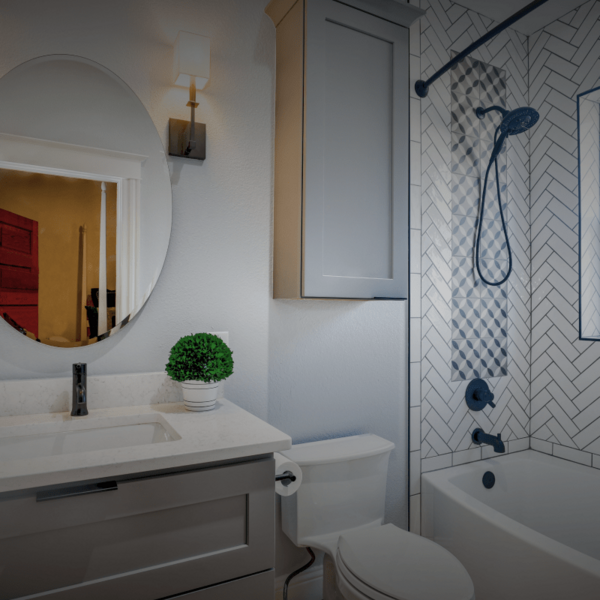What Are the Challenges of Living in a Tiny House with a Family?
A Tiny House can feel quite spacious for a single occupant, but what is it like when you’re sharing 200 square feet with three or four other people… plus maybe a few furry, four-legged family members?
Even if you’re just two people now, perhaps you have plans to have a family and are wondering whether that’s possible in a Tiny House.
While four or more people in a Tiny House might elicit mental images of hordes of people squeezed into a clown car, in reality there are strategies for making it work—harmoniously for the most part.
Tiny House Plans for Families of Four or More
Sleeping spaces
The primary consideration when creating or choosing a Tiny House floor plan for a family is the sleeping arrangements. Daytime activities can often take place with all or some family members out of the house. But at nighttime, everyone needs to fit snugly and comfortably inside.
What to look for in a Tiny House floor plan:
- Are there adequate spaces in the Tiny House for everyone in the family to sleep?
- What are the relationships of the sleeping spaces to each other? Should they be close together or far apart? How much privacy does each family member need?
- Do certain family members require closer proximity to the bathroom facilities?
- Is a loft bed suitable for any family members?
- What about bunk beds? Equipping bunks with a closable curtain across the front is one way to give each child a private space of her own.
Convertible sleeping spaces
Another useful strategy for family Tiny House floor plans is to include convertible sleeping spaces. This allows a nighttime bed to become a daytime sofa. Murphy beds are another convertible option. And hammocks can be a great way to fit in a number of sleeping spaces that can disappear into a closet or a storage ottoman in the daytime.

Image credit: HomeKlondike
Considerations around sleeping arrangements
How much space does a person really need? Modern society tends to want to put each person in their own private square room. But humans haven’t always lived this way. There are articles emerging about the benefits of communal sleeping, for example. Check out this one here.
Speaking of taboos around sleeping arrangements, the couple at the head of the family may have concerns about experiencing intimacy in a space without much sound or space privacy. Some couples address the issue by having regular overnight date nights at local hotels, leaving a babysitter with the kids. Others are simply relaxed about it, and opt for demonstrating a philosophy that this is a normal part of life, not to be hidden or shamed.
Wardrobe
Another potential challenge for Tiny House families is clothing storage. Any Tiny House dweller learns to deal with wardrobe limitations. Capsule wardrobes are key. With a number of family members sharing or limited available clothing storage space, it might make sense to keep only the current season clothing on hand. Off-season wardrobes might be stored with a friend or relative.
Tiny Houses for Large Families
Larger families will likely be more comfortable in Tiny Houses that are toward the less-tiny end of the spectrum. Expanding beyond the 8’-6" width may be well worth the towing permit fees for a large family. And choosing a model closer to a 40-foot length than a smaller 20-foot model will definitely allow more elbow room.
A few examples of the larger Tiny House options include:
Mint Tiny Homes’ Loft Edition
This spacious Tiny House by Mint Tiny Homes is available in lengths up to 34 feet (with the option of a steel frame to lighten the towing load). Its floor plan includes two sleeping lofts plus a downstairs bedroom.

More details on Mint Tiny Homes Loft Edition can be found here.
The Pemberley 37′ Gooseneck by Rocky Mountain Tiny Houses
Rocky Mountain Tiny Houses offers a 37-foot gooseneck Tiny House called The Pemberley. It runs 460 square feet including the loft and catwalk. In addition to the bedroom on the gooseneck, there’s a master bedroom in the rear of the house and a third bedroom in a loft.

To see more on The Pemberley, visit here.
Traveler XL from Escape Traveler
The Escape Traveler is 344 square feet and off-grid-ready. It sleeps up to ten people (assuming some of them are little people). A private queen bedroom is on the main level. In addition to sleeping lofts, there’s also a fold-down couch in the living room.

To see more details on the Traveler XL, visit here.
Strategies for Families Living in Tiny Houses
Attitude of gratitude
Focus on the benefits of the Tiny Life. Being debt-free allows you to more easily sample so many of the other experiences of life. Take the whole family to Greece or Iceland or Peru now that you’re not funneling all of your funds into a 30-year mortgage on a standard-size house. Have frequent adventures.
Prioritizing alone time
Alone time is important, especially for the more introverted members of the family. As there may not be much opportunity to do this inside the Tiny House, get out when you need to. Spend time outdoors in favorable weather. Take a long hike.
Even in winter weather, outdoor or out-of-the-house activities such as hitting the movie theatre can prevent cabin fever from building.
The kids can take off for sleepovers at their friends’ places. You may even wish to reciprocate and give their friends a sampling of Tiny House life.
Meeting the Needs of Family Members
Infants
Baby furniture
Katy Bowman, the biochemist & author of Move Your DNA, teaches about natural human movement and how to incorporate it into one’s daily lifestyle. She tells a story of the day she suddenly noticed the health benefits of carrying her baby with her throughout her daily activities. This is a long way of saying that you don’t need to fit a lot of specialized baby furniture into your Tiny House.
Whether you subscribe to the philosophy of allowing your baby to sleep in your bed with you, or opt to make space for a crib, it’s been done successfully in a Tiny House.
Baby-proofing a Tiny House
Less space means less need for baby gates and fewer hazards to baby-proof. And in a Tiny House, your toddler will generally be within eyesight if not arm’s reach.
Challenges to raising a baby in a Tiny House
It may be a bit more difficult to create a quiet environment in a Tiny House for daytime infant sleeping, given that all other daytime activities occur within earshot.
And laundry is something that usually has to be done more frequently, given the smaller loads possible in most Tiny House-sized laundry appliances.
Children
An education in values
Tiny House dwelling teaches the kids a different set of values than might be experienced in a more traditional setting. Living in a Tiny House automatically has a lessened focus on materialism, for example. You simply don’t have the option to mindlessly acquire “stuff,” as there’s no place to put it—especially when you’re sharing the already-limited space with others.
Learning good habits
Self-tidying is a necessary habit to be learned by all members of a Tiny House family. The Lego project in the middle of the floor is always going to be in someone’s traffic pattern.
Teaching respect for the environment
Living in a Tiny House also teaches environmentalism. Not only does the house itself take up less space and resources on the planet, but its systems use less energy. And a composting toilet is much easier on the planet than a chemical-laden septic or sewer system. It’s up to the individual family whether they wish to also incorporate water saving practices.
Homeschooling
Homeschooling becomes a more viable option with the Tiny lifestyle. The adults potentially have more time available with fewer work hours required to support a mortgage-free lifestyle. And if the Tiny House is located in a homesteading situation, there’s a wealth of valuable learning experiences available right on site. In an urban setting, incorporate museum visits and other cultural opportunities into your curriculum.
Tiny Love for Tiny Houses
There seems to be a misconception that younger kids will dislike being ‘cooped up’ in a Tiny House. The truth is, kids are enchanted by Tiny Houses. It’s almost like living full time in a tree fort or a playhouse. There are even reports from the Tiny House community that kids are more willing to help out with chores in a Tiny House than they were previously in a normal-sized house.
Teenagers
In a Tiny House, there generally isn’t the option of storming off and slamming doors. Tiny House families either are– or become– good at interpersonal communication.
As mentioned earlier, alone time IS important, and strategies should be in place for accomplishing that to the degree of each family member’s needs.
Some Tiny House families engage a strategy that involves helping teenagers build their own Tiny House structures as the need or desire for more privacy arises. Since the more complex elements of a house, such as the kitchen, are housed in the main family Tiny House, the teenagers’ structures can be very simple shed-like spaces. And the Tiny House evolves to a village of Tiny Houses.
Pets
Tiny House considerations for your furry, scaled, or feathered family members:
- space for pet beds (unless they share yours or are fine on the furniture or the floor)
- litter boxes (tip: a litter box in a bathroom cabinet allows you to make use of the bathroom’s exhaust fan to mitigate odors)
- food and water dishes
- pet food and supplies
- perhaps a pet door?
- pets in Tiny Houses may mean very frequent vacuuming, but they’re worth it, arent’ they?
Guests and Entertaining
There are sacrifices and compromises to be made for living in a Tiny House, for sure. You won’t be able to host house parties or traditional dinner parties. But there are alternatives.
You can save your entertaining for times of pleasant weather, and host outdoor barbecues and picnics. If the property you’re located on doesn’t facilitate this idea, move the gathering to a public park.
Birthday parties and other special events can take place at restaurants and rented banquet rooms, or at a friend or relative’s larger home.
And there’s a silver lining to not being able to host at your home: no dirty dishes, extra housework, or long hours in the kitchen. Granted, if you’re the sort who enjoys these things, you can always do the same party prep and clean-up at a friend or relative’s house. Or cohost a party with them for double the guests and double the fun.
Building a Tiny House for a Family
Given healthy allotments of time and patience, building your own home together is an amazing and memorable experience for the whole family. The construction project is a fantastic learning experience in and of itself—one that’s bound to stay with the kids far longer than many of the lessons learned while sitting at a schoolroom desk.
And all members of the family will share a special pride in a home in which they can recognize their own efforts made manifest.
Family Closeness
It won’t always be easy. Especially during a transition period from a standard house to a Tiny House, there are likely to be many collisions of the physical and the emotional sort. But Tiny House families find that a rhythm develops. It’s almost a subconscious dance that comes when people live in close quarters with each other, as humans have done for centuries before the invention of the larger-than-we-really-need house.

